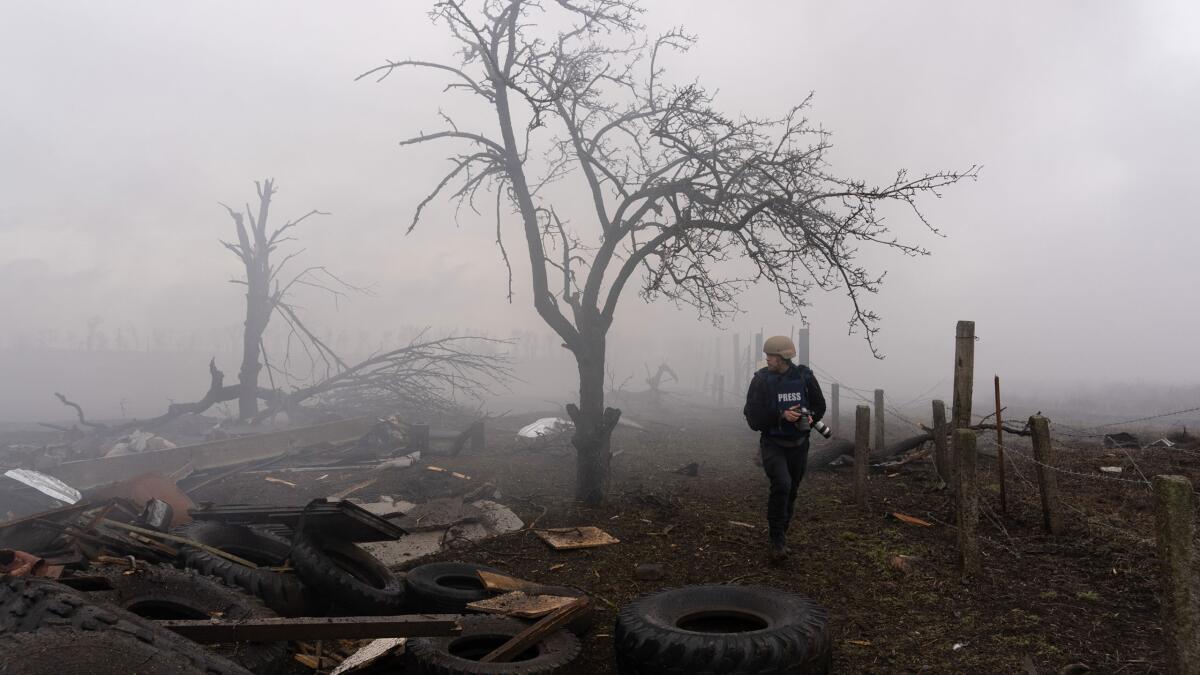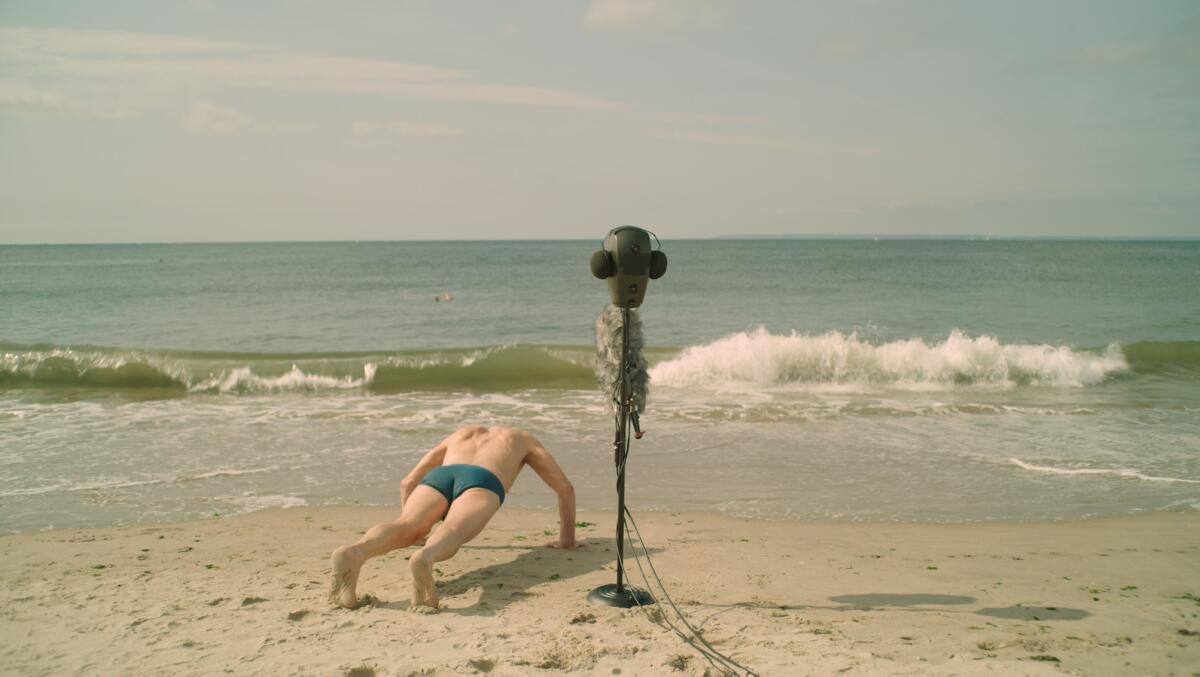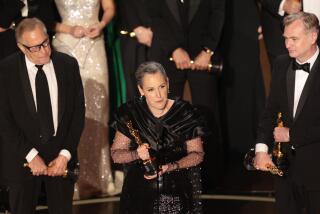How three Oscar contenders in documentary features stir the soul with harrowing, poetic stories

- Share via
A crowded field of strong contenders vie for Academy Award consideration in the documentary feature race this season, with more than 160 films submitted. The best of them bring focus to a vibrant range of themes and personalities, urgently mapping a volatile world. Here are three such projects, aiming for a spot on the Oscar shortlist, to be announced Dec. 21.
‘20 Days in Mariupol’
The Ukrainian war documentary “20 Days in Mariupol” is difficult to watch and hard to shake. It bears brave, unflinching witness to the Russian siege of the port city that began in February 2020 and ended three months later, with more than 20,000 people dead.
Mstyslav Chernov, a seasoned Associated Press conflict reporter and videographer, worked with a small team to capture the horror of the war’s early days. What the world first glimpsed in news clips was expanded into this diaristic account, at once humanistic and harrowing.
“For such complex stories as war, as conflict, as war crimes, the shorter forms of news don’t cover all the nuances and the context, especially in the times when information and news are used as weapons,” said Chernov, a native of Kharkiv, Ukraine. “One of the purposes of this work was to bring up the context of the scale of suffering and destruction, and the sheer quantity of human stories that were there.”
The film incorporates the struggle and risk of its own making, held steady by Chernov’s low-key narration.
“I didn’t want to pull attention onto my own feelings,” he said of the voice-over. His focus was direct. “It’s to show how it is to be stuck in a limited space in the limited time with all this, like a rope around your neck, that was tighter and tighter around the city.”

‘Going to Mars: The Nikki Giovanni Project’
Wired to the energy of its dynamic subject, “Going to Mars: The Nikki Giovanni Project” conveys the lifelong quest of the poet, educator and activist, now 80, while holding crisp focus on Giovanni as she moves through the contemporary moment. Even the title evokes forward motion, drawn from the poem “Quilting the Black-Eyed Pea (We’re Going to Mars),” which likens the space journey to the Middle Passage.
“It was the anti-biopic to the biopic,” said Michèle Stephenson, who directed the documentary with Joe Brewster. The filmmakers root the story in Giovanni’s point of view, using her voice throughout (although executive producer Taraji P. Henson reads a selection of her poems). “Sometimes I feel the frustration of wanting to hear more about the artist, but I hear more about other people talking about the artist than the actual work of the artist.”
Giovanni, who rose to prominence in the 1960s and ‘70s as a leading figure in the Black Arts Movement, plainly states that her memory is selective. “I remember what is important, and I make up the rest,” she declares in the film. But the filmmakers were unhindered by this, incorporating her health issues and refusal to revisit certain topics into the story. “There were aspects of her life that were just like, ‘Nope, that’s not happening,’” Stephenson said. “We turned those obstacles into opportunities.”
Brewster noted, “Ambiguity is our friend. In a lot of these biopics, exposition kills the film.” The filmmakers make inventive use of archival sources — including a historic conversation between Giovanni and writer James Baldwin, from the public broadcasting show “Soul!” — and space-themed footage. Whenever necessary, Giovanni’s poems speak volumes, and they inspired the film’s structure.
“We decided to cut the film in stanzas and build worlds and scenes around some of this poetry or some of the moments we really wanted to highlight,” said Stephenson, who added later: “In some ways the film feels more like a poem.”
Verité was the glue, Brewster said, “even if it’s her cooking the chicken or talking about plants.”
‘32 Sounds’
That rare film that invites its viewers to close their eyes to more fully absorb the experience, “32 Sounds” is a playful inquiry into our relationship with a single sense. The title, a nod to the 1993 documentary “Thirty Two Short Films About Glenn Gould,” points to an array of sounds that filmmaker Sam Green explores: a Foley artist creating the sound of a tree falling in a forest; the love cry of a tropical bird unaware that it is the last of its species.
As with much of Green’s previous work, it’s designed for performance, with the filmmaker narrating alongside a musical collaborator — this time, composer JD Samson (Le Tigre). Theatrical audiences, as will viewers of a streaming version, are encouraged to wear headphones. Mark Mangini, a two-time Oscar winner (Denis Villeneuve’s “Dune,” “Mad Max: Fury Road”), was the sound designer.

“The fun and challenge was to pick 32 sounds that interested me and also resonated together to make a bigger set of ideas,” said Green, a 2003 Academy Award nominee for his more conventional film “The Weather Underground.” He enlisted Nels Bangerter, whose credits include such “modular” documentaries as “The Hottest August” and “Cameraperson,” to edit the film with him. “[It’s] that thing of making something that could be in any order. There’s no chronology, there’s no conflict, there’s no main character,” Green said. “Anything could go anywhere, which is really hard to make it work for 90 minutes.”
“32 Sounds” was made during the COVID-19 pandemic, which Green believes has something to do with the emotional chord it strikes with audiences.
“I think everyone still has a lot of buried feelings from that,” Green said. “I’ve wondered why does this weird movie about sound elicit this kind of response. I’ve never had a movie that seems to touch people in this way.”
More to Read
From the Oscars to the Emmys.
Get the Envelope newsletter for exclusive awards season coverage, behind-the-scenes stories from the Envelope podcast and columnist Glenn Whipp’s must-read analysis.
You may occasionally receive promotional content from the Los Angeles Times.










